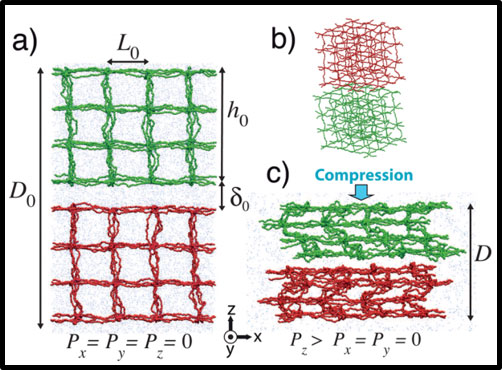Energy Conversion in Polyelectrolyte Hydrogels
August 3, 2015
Scientific Achievement
Molecular dynamics (MD) simulations demonstrate that upon deformation, hydrogels adjust their conformation predominantly by altering their electrostatic interactions.

Illustration of compression simulations of a double hydrogel system of identical gels with a charge fraction f= 0.5 and polymerization degree N = 128.
Counterions are rendered as dots. (a) Underformed hydrogel slabs separated initially by a gap of thickness δ0, (b) 3D view of the hydrogels, and (c) uniaxially compressed gels.
Significance and Impact
The ability to significantly adjust their electrostatic interactions in response to external fields or mechanical deformations make hydrogels ideal candidates for energy converters and actuators.
Research Details
- A double gel system was designed in which two semi-infinite hydrogel slabs are separated by a large polymer-free region, to which counterions can escape.
- The relationship between deformation and energetic changes in PE hydrogels was investigated by means of MD simulations.
- Electroneutrality condition inside the gel causes the charged backbone and counterions to rearrange themselves upon compression to reduce the total electrostatic energy and form ionic structures.
Energy Conversion in Polyelectrolyte Hydrogels
Erbas, A., Olvera de la Cruz, M.
ACS Macro Lett. 8, 2015, 857–861.
Work performed at Northwestern University
